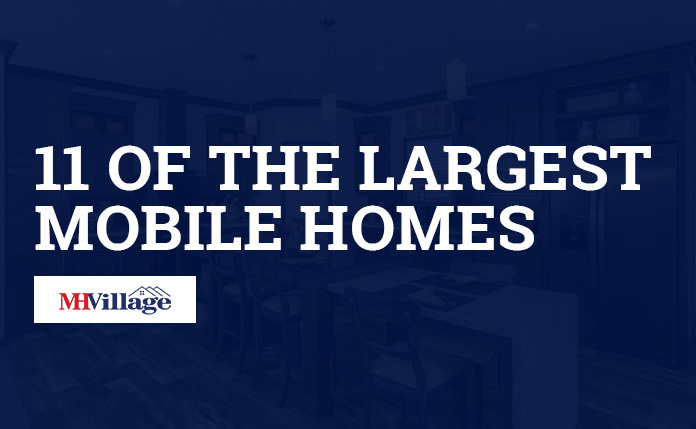Part One: How to Read and Understand Mobile Home Floor Plans
If you are looking to buy a new manufactured home, it’s important that you know how to read and make sense of manufactured and mobile home floor plans. While some mobile home dealers will likely have homes onsite that you can walk through, they also are likely to have a number of home models that you can purchase or customize. Being familiar with the floor plan will make it easier for you to understand the home’s layout when walk-throughs aren’t an option.
Floor plans tell you about a home. Of course, it will show the size of the home. But a good floor plan also will tell you the size of the rooms, the way the doors open for those rooms, even where the appliances are in the kitchen and bathroom. Get to know these features, they will ensure that you choose the best make and model for your manufactured home.
Example of a Double-Wide Mobile Home Floor Plan:
To start, a floor plan is drawn from a bird’s eye view. Meaning it’s drawn from above – as if the roof was removed and you were looking down on it. Here you can identify the main rooms pretty easily. Take a look at the photo below showcasing a multi-section manufactured home.

To start with, all the walls are solid lines. (On some floor plans, they are filled in with a pattern.) The breaks in these lines indicate doors, windows and openings between rooms.
Can you find the front door? It’s in the living room. Imagine walking into this home. You can see which areas of the floor are carpeted (in brown), and the areas that are tiled (the grid pattern). This home has what’s considered to be an “open floor plan” – notice that there is not a wall between the living area and the kitchen.
In addition, notice that this mobile home has a second door to the outside through the Utility room. Notice the ways the doors are drawn. On the front door, the door swings into the living area. On the back door, it swings outside. Of course, that is fairly common. The reason it matters is that now you can see which way all the doors swing – and that can make a difference in where you plan on putting your furniture.
Windows
As you can see, the windows on this floor plan are white with double lines. Additionally, notice the notes around the edges of the floor plan – this home has optional windows. So, in this model home, you can add an extra window in bedroom #3, one in the master bedroom, and you can choose to have a large three-panel window in the living area.
Occasionally windows will have slightly different symbols. These could indicate bay windows or casement style windows.
Sinks and Tubs
One of the other things you can see in a floor plan is the location of the toilet, sinks, bathtubs. In this little floor plan example from Adventure Homes you can see the location of a large garden tub, a shower, double sinks and a toilet.
Likewise, in the kitchen, you can see the placement of the stove, sink and refrigerator. Here’s something to note: you can see in the floor plan above that the home comes with a stove, but the washer and dryer are optional. Again, this is standard, but good to know when you shopping for homes.
Also, the floor plan will include built-in cabinets. It is in the floor plan above in light gray.
Do an Imaginary Walk Through of the Floor Plan
When you are shopping for new homes make sure to look at as many mobile home blueprints as you can. Walk through them with your mind, and go from room to room. It will help you get familiar with seeing different mobile home layouts and styles.
Part Two: How to Select the Right Manufactured Home Floor Plan
Once you’re comfortable with reading and interpreting a floor plan, you still have some big choices to make when searching for a new manufactured home.
From the size and shape to where the rooms are located, selecting the right mobile home layout can affect how you experience your new residence. The Michigan Manufactured Housing Association has contributed five tips to help you choose the right floor plan for your mobile home.
1. Decide what home size will best suit your family
Selecting the right floor plan should start with what size home will fit your lifestyle. Assess how many bedrooms are essential for children, if you need extra space for guests, or if you require a large kitchen for family meals. Manufactured home floor plans come in a wide variety of sizes, with popular options ranging from 1,400 to 2,000 square feet, and from two to four bedrooms.
2. Make your decision based on the mobile home layout, not the finishes
You’ll likely be touring model manufactured homes before you make your floor plan choices. Ensure you are basing your decision on how the home flows and might function for your daily activities. It’s hard to not be wowed by the upgraded floors, countertops, and furniture in the model home, but try to imagine the home in a “stripped down” state. Then, once you select your floor plan, you can make finish decisions based on the models that you loved.
3. Ask your sales consultant for guidance
While you may know what you want in your next home, a manufactured home sales consultant in your selected community could help you with additional considerations. He or she may provide advice related to energy-saving features, anticipated utility costs, or even common maintenance.
4. Know your budget limits before selecting a floor plan
Before getting your heart set on one floor plan, know what the costs are associated with the home. Have your finances in order and stay within what you can comfortably afford. Ask your sales consultant to break down costs as you narrow down to the floor plan that fits within your budget.
5. Determine if you will keep existing or buy new furniture
While you may only be thinking about the rooms and layout of your floor plan, choosing furniture is a major investment. If you decide to use your current furniture in your next home, ensure you measure it and take this into account when reviewing plans.
Trust your instincts
Above all, trust your instincts. You have the ability to “feel” when a space feels comfortable. Take these instincts into consideration when looking at different manufactured homes. You may be surprised by how many manufactured home options you will have. Listen to what speaks to you.

